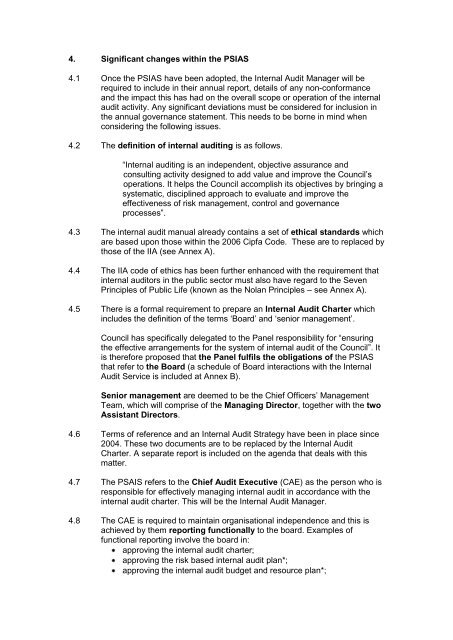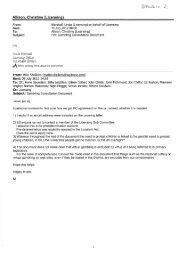Public Sector Internal Audit Standards PDF 146 KB
Public Sector Internal Audit Standards PDF 146 KB
Public Sector Internal Audit Standards PDF 146 KB
You also want an ePaper? Increase the reach of your titles
YUMPU automatically turns print PDFs into web optimized ePapers that Google loves.
4. Significant changes within the PSIAS4.1 Once the PSIAS have been adopted, the <strong>Internal</strong> <strong>Audit</strong> Manager will berequired to include in their annual report, details of any non-conformanceand the impact this has had on the overall scope or operation of the internalaudit activity. Any significant deviations must be considered for inclusion inthe annual governance statement. This needs to be borne in mind whenconsidering the following issues.4.2 The definition of internal auditing is as follows.“<strong>Internal</strong> auditing is an independent, objective assurance andconsulting activity designed to add value and improve the Council’soperations. It helps the Council accomplish its objectives by bringing asystematic, disciplined approach to evaluate and improve theeffectiveness of risk management, control and governanceprocesses”.4.3 The internal audit manual already contains a set of ethical standards whichare based upon those within the 2006 Cipfa Code. These are to replaced bythose of the IIA (see Annex A).4.4 The IIA code of ethics has been further enhanced with the requirement thatinternal auditors in the public sector must also have regard to the SevenPrinciples of <strong>Public</strong> Life (known as the Nolan Principles – see Annex A).4.5 There is a formal requirement to prepare an <strong>Internal</strong> <strong>Audit</strong> Charter whichincludes the definition of the terms ‘Board’ and ‘senior management’.Council has specifically delegated to the Panel responsibility for “ensuringthe effective arrangements for the system of internal audit of the Council”. Itis therefore proposed that the Panel fulfils the obligations of the PSIASthat refer to the Board (a schedule of Board interactions with the <strong>Internal</strong><strong>Audit</strong> Service is included at Annex B).Senior management are deemed to be the Chief Officers’ ManagementTeam, which will comprise of the Managing Director, together with the twoAssistant Directors.4.6 Terms of reference and an <strong>Internal</strong> <strong>Audit</strong> Strategy have been in place since2004. These two documents are to be replaced by the <strong>Internal</strong> <strong>Audit</strong>Charter. A separate report is included on the agenda that deals with thismatter.4.7 The PSAIS refers to the Chief <strong>Audit</strong> Executive (CAE) as the person who isresponsible for effectively managing internal audit in accordance with theinternal audit charter. This will be the <strong>Internal</strong> <strong>Audit</strong> Manager.4.8 The CAE is required to maintain organisational independence and this isachieved by them reporting functionally to the board. Examples offunctional reporting involve the board in:approving the internal audit charter;approving the risk based internal audit plan*;approving the internal audit budget and resource plan*;


